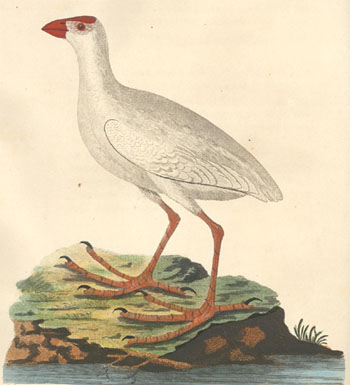- Lord Howe Swamphen
Taxobox
name = Lord Howe Swamphen

status = EX | status_system = IUCN3.1
extinct = early 19th century
regnum =Animal ia
phylum = Chordata
classis = Aves
ordo =Gruiformes
familia =Rallidae
genus = "Porphyrio "
species = "P. albus"
binomial = "Porphyrio albus"
binomial_authority = (Shaw, 1790)The Lord Howe Swamphen or White Gallinule, "Porphyrio albus", was a large
bird in the familyRallidae endemic toLord Howe Island ,Australia . It was similar to thePurple Swamphen , but with shorter and more robust legs and toes. Its plumage was white, sometimes with a few blue mottles, and it was probably flightless, like its other close relative theTakahe . Similar, entirely blue birds were also described, but it is not clear if they belong to this species or are simply Purple Swamphens (which can also be found on the island). The feathers on the two extant skins are white.This bird was first described by John White in his "Journal of a Voyage to New South Wales" (1790), which also contained an illustration. It was not uncommon when the bird was first described, but was soon hunted to extinction by whalers and sailors.There are two skins of the bird in existence, in the museums of Liverpool and Vienna. There are also several paintings, and some subfossil bones.
ee also
*
Extinct birds References
* Database entry includes justification for why this species is listed as extinct
Wikimedia Foundation. 2010.
